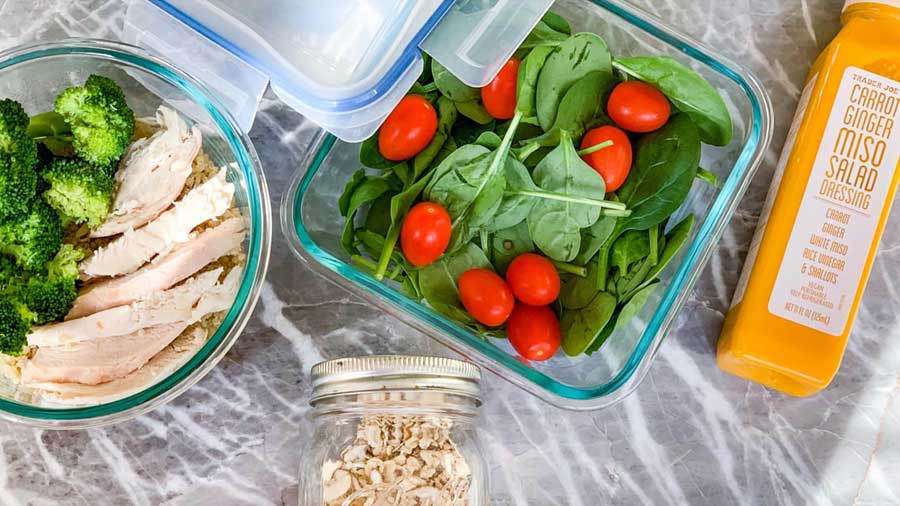The reign of meal prep seems to have come to an end with its frugal cousin, batch cooking, taking over kitchens during lockdown periods. Both food prep trends are meant to benefit the lazy foodie, who want to eat well or eat right but don’t have the time or the energy to spend hours in the kitchen to cut, peel, chop or grill on a daily basis. But unlike meal prep, batch cooking lets you eat fresher and also accommodates your cravings, to an extent.
Both meal prepping and batch cooking are meant to save time, but the latter leaves some room for last-minute quick fixes and also helps avoid food wastage. Batch cooking is especially easy in Indian kitchens where a selection of handy spices, condiments, dried fruits, chickpeas, lentils, yoghurt, poha is usually available, give or take a few exceptions.
“My motto is why make one when you can make two? This is about time management and getting it done as quickly as possible,” says Suzanne Mulholland, who wrote the book, The Batch Lady. Shop Once. Cook Once. Eat Well All Week. The author’s YouTube page is a treasure trove of batch cooking ideas and also has detailed instructions on how to shop and stock your pantry if you’re planning to cook in batches.
So, what is the difference?
Meal prep is geared towards the idea of pre-portioning. It typically involves spending a few hours on a specific day of the week to prepare all of your meals for the upcoming week. You essentially need to cook in bulk and you can have lunch and dinner ready for the next seven days, which just need to be heated. If you like knowing exactly what you will have for a full week — which, a shocking number of people do — then meal prep is your thing.
Batch cooking, on the other hand, is simply about planning ahead and leaving some wiggle room. This method focuses on meal components that you can use throughout the week in different ways. A cooked dal or lentil chops, a black bean dip, a large side of baked tofu or baked coconut, stovetop tikkas, idli podi, quinoa upma, soya cutlets are good examples. These don’t contain fresh-cut veggies or fish, which have low shelf life. Most plant-based proteins are ideal for batch cooking since they are easily freezable and versatile as sides.
Meal prepping entails eating the same meal for an entire week. It does help you keep track of your calorie intake and saves you the trouble of planning dinner for your family, or even yourself. Batch cooking, however, makes planning your meals more fun and helps you widen your palate.
It doesn’t bring your cooking time to zero, like meal prepping, but helps you eat fresher and more interestingly, so you can still listen to your cravings.
To be specific…
If you’re meal prepping for an entire week, you are cooking at least 4-5 different things. A typical prep includes grilled meat or marinades, chopped salads, roasted veggies, oatmeal jars, freezer burritos or healthy tacos, protein-rich stews etc.
Batch cooking however is a little more indulgent and gives you some control over how you want to design your meals. For instance, if you’re planning on making some grilled chicken and want to use some of it in your salads, or for picnic sandwiches later in the week, you can make double the amount and freeze it. Midway through the week, you can take stock of what’s left in your freezer and use up the cooked or prepped items, any way you like.
To put it simply, batch cooking is about being ready for your cravings and maybe even weeding out unhealthy eating patterns because it’s more sustainable as a habit.
Want cheesy pasta? How about an eggplant lasagne that has lesser carbs but most of the fixings? Craving luchi mangsho for dinner? How about a pre-made chicken balti curry and whole wheat bhatura? If you’re batch cooking, you don’t have to scrap a thoughtfully portioned meal for last-minute takeouts just because you’ve got a hankering.
“I highly recommend batch cooking things like brown rice, chicken, roasted veggies, homemade chicken broth, lentils, or pesto so you always have something healthy to grab for when you're hungry,” says celebrity chef and author Giada De Laurentiis.
Batch cooking for beginners
- Don’t overrule all frozen options: Frozen veggies and fruits or frozen stock cubes can come in handy when you’re new to batch cooking
- Start small: Unlike meal prep, you can start batch cooking with very few ingredients. Make 2-3 simple recipes to get you halfway through the week, to see if the system works for you
- Replace your one-pot meals with course-based ones: They’ll help pack in more nutrition and use up leftovers.
- Choose the right food: Not all cooked preparations hold their shape. Soups, stews, casserole-style bakes, cooked rice dishes can be stored away for a few days. Foods that don’t do well in batch cooking are most greens, potatoes, anything with cream cheese, cooked fish etc.
